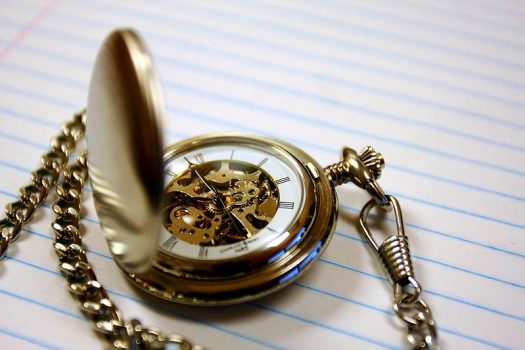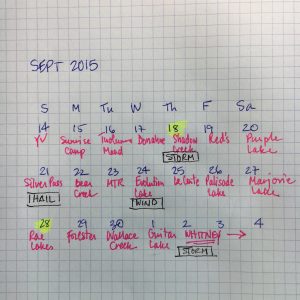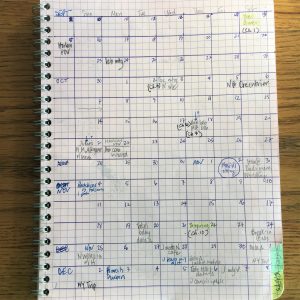Giving Your Story the Time of Day
By Sonja Yoerg | May 4, 2020 |
 Ever have a week with two Fridays? Sounds like fun but if it happens in your novel, your readers won’t be amused. As writers we can be forgiven for being so consumed by our writing that we lose track of what day it is. Unfortunately, if we lose track of time in the story, we might struggle to sort it out after the fact. And if the errors make it past a copy editor—and believe me, they do—you could confuse or annoy your readers.
Ever have a week with two Fridays? Sounds like fun but if it happens in your novel, your readers won’t be amused. As writers we can be forgiven for being so consumed by our writing that we lose track of what day it is. Unfortunately, if we lose track of time in the story, we might struggle to sort it out after the fact. And if the errors make it past a copy editor—and believe me, they do—you could confuse or annoy your readers.
I’m here to give you some tips for minimizing lapses in time continuity.
Use Real Dates. Sure, you can make up your very own calendar year, but consider the advantages of using a real one.
- You can download or copy one from the internet. No need to remember when the leap year falls or to wonder whether Easter should be late or early—you’ll know!
- Real calendars connect to real events, such as holidays, historical events, moon cycles, movie release days, etc. These real events will add to the verisimilitude of your story and head off gotchas from pesky fact-checking readers. For date-to-date calculation, celestial events, weather, world clocks, etc., try timeanddate.com. To see historical events during a particular timeline, try ourtimeline.com.
- Make room for serendipity. I can’t tell you the number of times using a real calendar has dropped an opportunity into my lap. For instance, my main character traveled to L.A. to visit her mother. If it weren’t for the calendar, I wouldn’t have realized it was Mother’s Day, the perfect occasion for inducing misery.
Pin Your Characters to the Calendar
- Giving characters birthdays (or at least birth months and years) will ensure you always know how old they are. When I have kid characters that feature prominently (my WIP has nine!), I plot out their grades as well as their ages for every year.
- Mark anniversaries and other life-changing events, too. Think of it this way: if you have your married characters fight during the week of their anniversary, it’s a bigger deal than during other times. The anniversary of a death or miscarriage might also be powerful, or add nuance, but you have to know when it is.
Keep Track of Time as You Write
- Depending on the novel’s timeline, the tools you need will differ. A lengthy timeline might benefit from a spreadsheet, while an abbreviated one could be captured on a single page. I dedicate a notebook to each of my novels and put the timelines in there. For me, not having to click away from the document makes checking the timeline a snap. Here’s a simple one for my second novel, Middle of Somewhere, which takes place during a three-week hike on the John Muir Trail. I noted the nightly campsite so I could readily locate the characters in space and time.

My upcoming release, Stories We Never Told, takes place over several months. Here’s one page of the calendar. The next page is densely packed because the action ramps up, but I didn’t want to include spoilers!

- Be redundant. I also note the date and time for each chapter or scene in the manuscript. I use Scrivener so when I share the compiled version I delete the dates, never deleting them in Scrivener. If you use Scrivener, you can use notecards for this, too.
Coping with Multiple Timelines/multiple POVs
- Track each separately, but also have some method for showing how they intersect in the narrative. In Scrivener I would do this with different colored labels for each timeline. (I’d have a version of it in my notebook, too, for quick reference.)
- If you have two or more POVs running separately in the same timeline, it’s important that when the characters meet up three days hasn’t passed for one and two days for another. I’d put temporary time tags absolutely everywhere with this structure—and make sure the reader has sufficient clues to be reassured no one is time traveling (unless they really are).
I’ve shared some of my tricks for keeping time but as with everything in this business, no solution is for everyone. What techniques do you use to track time in your stories? Do you have any resources to share?









Sonja, I love all your tips. I caught on to the importance of timelines after several revisions of my first novel (now I look for evidence of them them when I read) I started making timelines for each character, ending up with a hybrid sort of bio. On book #2, I considered it as part of the drafting process. I actually looked up whether there even was a Leap Year in 1979. I also have a handwritten timeline from day one of the story to the end. As I draft, I put the date and day at the head of each chapter (or a note in a scene if it changes). It’s keeping me sane instead of lost and panicky. I like doing these thing on paper so, like you, I don’t have to bug out of the document. Plus I’m old-fashioned. Thank you for this. It’s very helpful!
Susan,
Yes, some lessons–most of them–are learned the hard way. Sounds like you’ve hit upon some methods that work for you which is the only thingt that matters. Putting the date on each scene is such a smart move, and so easy!
Glad you found my ideas helpful!
Sonja
I love running into a fellow real calendar user. My first book had three timelines and the plot was intertwined with real, well-known events, so I had to be sure I didn’t fudge dates–history buffs will know when you’re incorrect and then you lose the reader’s trust.
Even when historical events don’t figure in, I still pay attention to real dates, specifically moon phases (you don’t want your reader to realize you’ve had a full moon in the sky for weeks) and weather. I don’t want to pretend it was a particularly hard winter in a particular year if, in reality, it was quite mild. Readers who were alive at the time might just remember that.
And you’re right about how using a calendar and paying attention to actual events can make your story richer. Holidays, news stories, all that background noise during a particular year is, at least, excellent set dressing for your story that makes it feel more real.
Erin,
Nice to found another member of the Real Calendar club! One thing I didn’t mention is that using a real calendar somehow makes the story feel more authentic to me as I’m writing it. I check to see what movies were playing, for example, and imagine which my characters would chose. It makes me feel closer to them, as if we shared a past.
Btw, “set dressing” is a great phrase!
Sonja
Yes! The story I am working on now starts on December 31, 1989 and will cover all of 1990. I have a huge timeline I’ve made with movie releases, song releases and concerts (the characters are musicians), political events, and other stuff that might appear in the background (and just for jogging my own memory since I was only 10 that year). Plus I have a private Pinterest board filled with magazine covers from December 1989 to December 1990. It’s actually been really fun to remember that year as I’ve gathered all that information.
I almost had two Fridays in my latest draft until I caught it yesterday.
Stopwatches can be useful too. I’ll time a scene and ask myself if a conversation went too long or too short for that particular relationship. I wouldn’t have a two-minute chat with a friend I haven’t seen in a year, and I’ve never spent twenty minutes discussing the issues another friend is going through.
Thanks Sonja for the great reminder.
James,
A stopwatch! I never would’ve thought of that. I find reading dialogue scenes out loud usually tells me whether the conversation is the right length, but maybe timing them would be a useful adjunct.
Glad you found my comments useful.
Sonja
This is very helpful. I’ve written two novels, both cozy mysteries, where the action takes place over a few weeks. Still, keeping track of the days of the week was important and I had to make notes to be sure I didn’t “re-use” one of the days. Scrivener is a great tool.
Since my novels are designed to be a series, I realize now I should go back and retroactively create a calendar for each book so I don’t trip myself up on the next one. Great ideas. Thanks.
Oh, and my novels constitute the “Watch series.” Another reason this post is so “timely!”
Kay,
I never thought about the particular issues of time in a series; thanks for bringing that up. Creating a calendar post-hoc shouldn’t take very long and will undoubtedly save you some time in the long run. Good luck with your series!
Sonja
A few years ago, I attempted a romance novella for an anthology. Timeline ran from October to Christmas. Using the calendar and its information, I was able to have my heroine navigate a south facing lake cabin by full moonlight in the middle of the night. Loved that calendar.
Judith,
Do you mean you picked her excursion to coincide with the full moon, or that the calendar happened to align with her outing? Either way, sounds like a real calendar was a boon to your story.
Sonja
You’re right – keeping a calendar was essential to me in my novel coming out next spring. There was an mid-term election in November that set the groundwork and then I backed up about three months. But since it had a workplace setting, I had to plan out so an action didn’t occur at the PR office on Saturday, but during the week (though I guess if it was set now, every day could have been a work day). Once I got the time frame set, it made everything a lot easier.
Maggie,
Yes, sometimes the logistics of making a story fit into a realistic timeline is like trying to giftwrap an octopus.
So true about workdays now. The good news is that Monday is just another day…
Sonja
I’m going to have to start doing this. I’m working on editor’s revisions on my 3rd novel. Time continuity has been a big issue in all 3! Thanks for this.
Denise,
Once you get into the habit of keeping close track of time, you’ll never go back, I promise. You will be so smug about knowing whether it’s Tuesday or last Thursday. :)
Good luck with your revisions!
Sonja
Something I’ve learned to do is put “time reference” in brackets [tr], in my draft, whenever I mention anything date- or day-related, whether it’s how long a trip should take or a character should be gone, or anything really. It makes it easy to search all those references to be sure they are consistent and make sense after revision.
Nicole,
Definitely stealing this idea. Time is so slippery, you have to pin it down multiple ways, don’t you think?
Sonja
Great tips, Sonja. As a writer of historical fiction, I rely on calendars and I esp. like that timeanddate also points out things like holidays, the phases of the moon, etc….I’ve not yet had 2 Fridays in a week or too many dark nights in a month.
Vijaya,
Yeah, you historical fiction types are usually pros at this stuff because you have to be. The rest of us learn from you!
Sonja
All great tips! Love the point about anniversaries and holidays being ripe times for conflict. Also watch for and note regular commitments — when the main character’s shop opens, the Wed morning staff meeting, Tues movie night, the employee who leaves early to pick up kids from school. In series fiction — I’m another cozy writer — these events create verisimilitude and ease reader identification; they also guide the plot because you know your MC has to be in her shop at certain times, and meets a friend for brunch and a walk on Sunday.
Leslie,
Sounds as though you have solid tools for keep track of when your characters are doing what. And you are so right about schedules helping to support–or even drive–the plot. Sometimes a constraint is an opening.
Sonja
A great article and one that is very valuable. Yes… even though I write the far future, I use a real calender – Siri gives me dates, so long as I give her the year and month! And I keep notes as I go, and then one of my drafts during the editing process is a timeline version, where I make a note of the time, day and date in the margin for every scene, using TrackChanges. It invariably exposes any narrative timeline anomalies…
The future is a click away–I love it! I’ve never thought of doing a timeline draft, but it’s an interesting idea especially if the timeline is complex.
Sonja
Great article. I wish I could have read this a few years ago. After a painful rewrite, I started putting a header at the top of each scene (it will be removed later) with the where, when, and weather listed. The historical weather observations for an area can be found on NOAA’s climate web site, https://w2.weather.gov/climate/index.php.
Bill,
Sorry I couldn’t save you from that painful revision but no doubt the lesson was learned. I also pay attention to weather details; you never know what real events may provide inspiration.
Sonja
Oh, yes. I absolutely have to have a calendar to be sure all my time references (“three days later”, etc.) are correct. When I was writing my memoir, which covered five years, I wrote my children’s ages at the top of every chapter so I could keep the chronology and age references straight.
The protagonist in my WIP is a public school teacher so I also have the school calendar overlaid on my story calendar.
Barbara,
That’s a great way to track the age of children. I’ll bet a brithday never caught you by surprise as has happened to me. Good luck with your WIP!
Sonja
Hi Sonja,
I am still writing my frist story and I do find it difficult to remember the time and days of the week in the story.
I use to write on paper and it was always easy to write notes somewhere in the bottom and I would see it when I return to writing later.
Thank you for sharing your tips. I will make sure to have a calender and write important dates and also the timeline of the story.